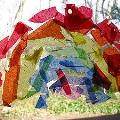My family is a blend of Irish and Scottish, and my husband’s family is Slovenian. This, I think, officially makes my children American Melting Pot babies, and since my children then married people from different ancestries, it certainly makes my grandchildren part of the grand tradition of acclimation into the United States.
Much like many immigrant families, we have stories of grandparents coming on ships overseas, settling in culturally defined downtown areas based upon the languages they spoke, working in trade jobs to create the American Dream for our parents, and in turn for us and our children. Of embracing their new communities while holding to traditions that were important to them. Some of them may seem silly to outsiders and even our own children, I remember how my daughter laughed when her grandmother suggested she dance with a broom at her wedding. But some we hold fast to and even see others from outside of our family adopt – like the great feast of St. Patrick, now know as St. Patrick’s Day.
As a grandparent I like to take holidays like St. Patrick’s day and teach my grandchildren a little bit of their own family history – who were the Murphy Clan, what our crest looks like, what the McLellan’s family motto (Think On) really meant and why we have such storied tradition of negotiation first, but battle if necessary. And I love to sit and spin tales to my grandchildren about how an Irish family and a Scottish family came together and why this is important not just for their identity, but as a model for how they should accept and try to understand others. We are proud of each piece of our history, and I am excited to share with you some of that.
Facts about St. Patrick’s Day Holiday
St. Patrick’s Day is observed on March 17 because that is the feast day of St. Patrick, the patron saint of Ireland. It is believed that he died on March 17 in the year 461 AD. It is also a worldwide celebration of Irish culture and history. St. Patrick’s Day is a national holiday in Ireland and a provincial holiday in the Canadian province of Newfoundland and Labrador.
In Ireland on St. Patrick’s Day, people traditionally wear a small bunch of shamrocks on their jackets or caps. Children wear orange, white and green badges, and women and girls wear green ribbons in their hair. My daughter who lived in Europe for a time actually traveled to Dublin with her friends one year to celebrate St. Patrick’s Day, and what a pub crawl it was – teams of four dress alike and travel from location to location on a treasure hunt, at the end of the day there is actually a team winner. It is quite an adventure – perhaps one you might want to have for the adults sometime.
Many cities have a St. Patrick’s Day parade. Dublin, the capital of Ireland, has a huge St. Patrick’s Day festival from March 15-19 that features a parade, family carnivals, treasure hunt, dance, theatre and more. In North America, parades are often held on the Sunday before March 17. Some paint the yellow street lines green for the day! In Chicago, the Chicago River is dyed green with a special dye that only lasts a few hours. There has been a St. Patrick’s Day parade in Boston, Massachusetts since 1737. Montreal is home to Canada’s longest running St. Patrick’s Day parade, which began in 1824.
Facts about Saint Patrick
St. Patrick was born in 385 AD somewhere along the west coast of Britain, possibly in the Welsh town of Banwen. At age 16, he was captured and sold into slavery to a sheep farmer. He escaped when he was 22 and spent the next 12 years in a monastery. In his 30s he returned to Ireland as a Christian missionary. He died at Saul in 461 AD and is buried at Downpatrick.
Facts about the Irish
34 million Americans have Irish ancestry, according to the 2003 US Census. That’s almost nine times the population of Ireland, which has 4.1 million people.
Some American towns have “Irish” names. You could visit: Mount Gay-Shamrock, West Virginia; Shamrock Lakes, Indiana; Shamrock, Oklahoma; Shamrock, Texas; Dublin, California and Dublin, Ohio.
The harp is the symbol of Ireland. The color green is also commonly associated with Ireland, also known as “the Emerald Isle.”
The Irish flag is green, white and orange. The green symbolizes the people of the south, and orange, the people of the north. White represents the peace that brings them together as a nation.
The name “leprechaun” has several origins. It could be from the Irish Gaelic word “leipreachan,” which means “a kind of aqueous sprite.” Or, it could be from “leath bhrogan,” which means “shoemaker.”
Facts about Clovers
According to the Guinness Book of World Records, the highest number of leaves found on a clover is 14! So I guess finding the one with four no longer seems like such a feat.
One estimate suggests that there are about 10,000 regular three-leaf clovers for every lucky four-leaf clover. If you are lucky enough to live in a mild climate, you and the kids could adventure out on a four-leaf clover hunt.
Legend says that each leaf of the clover means something: the first is for hope, the second for faith, the third for love and the fourth for luck.





